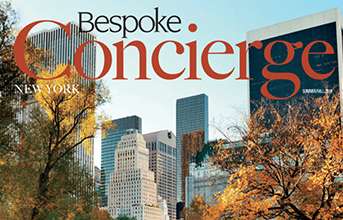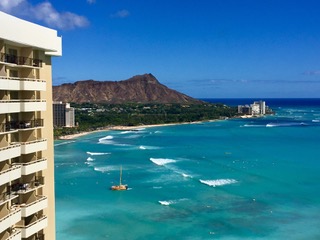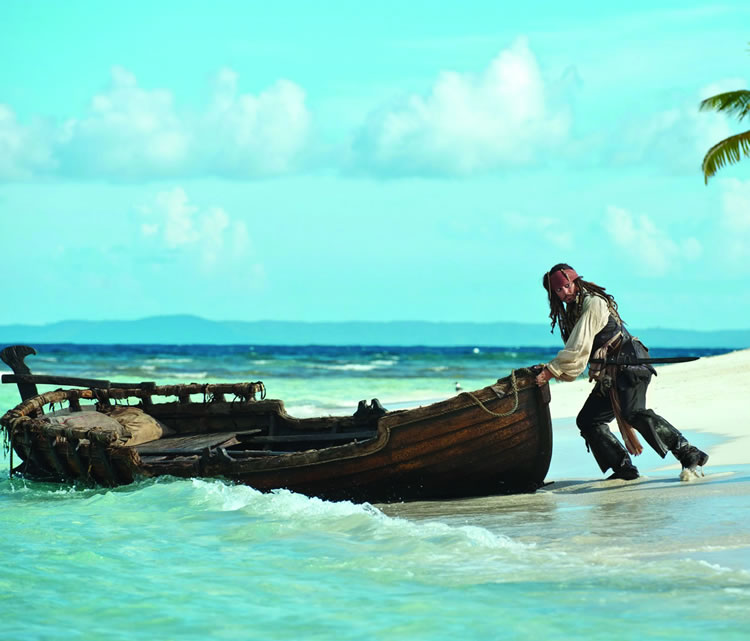

With its tropical scenery and indelible history, Puerto Rico has become a filmmaking force of nature.
By Peter A. Balaskas
There is a sensual mystique that inhabits Puerto Rico. Deep within El Yunque National Forest, tropical birds happily chirp as though beckoning tourists to enter their lush domain. On the coast, the ancient Castillo San Cristóbal fort looms over all like a stoic guardian protecting Old San Juan. Meanwhile, the Arecibo Observatory continuously scans the heavens with silent, majestic patience. And, just as the stars shine above at night, the ivory-colored sandy beaches sparkle in the daytime sun along with the aquamarine waters that hug their shores.
Anyone may experience this cinematic-quality landscape by touring the main island and its neighbors, savoring the different facets of seductive beauty. And yet, the exotic splendor of these breathtaking locations attracts a special kind of visitor: the American filmmaker. In fact, the island’s breathtaking vistas have starred in dozens of movies and television shows—sometimes presented as Cuba, Spain or even the Middle East—including the mega-blockbuster franchise “Pirates of the Caribbean.”
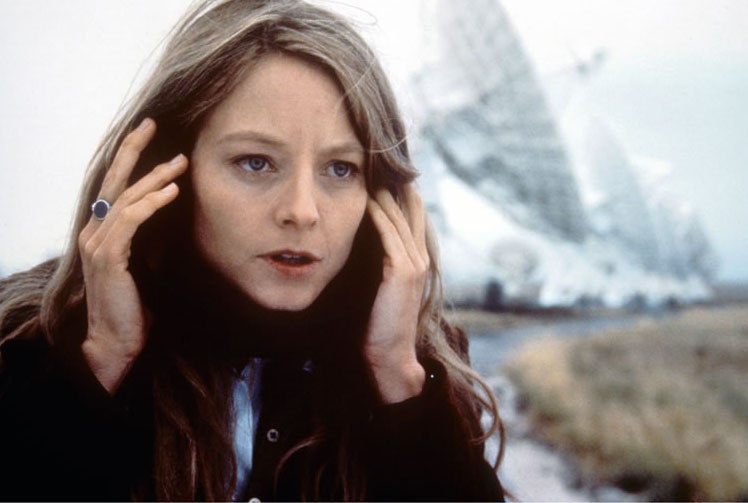
Movie aficionados might also recall that the 1997 science fiction film “Contact”—starring Oscar winners Jodie Foster and Matthew McConaughey—begins at the Arecibo Observatory. In addition, the world’s largest single-dish radio telescope doubled as a gigantic Cuban satellite dish where the famous fight sequence took place in the 1995 James Bond film “GoldenEye.”
From “The Rum Diary,” starring Johnny Depp, to “The Men Who Stare at Goats,” a George Clooney comedy, Puerto Rico has served as the backdrop for more than 60 movies between 1994 and 2012, in addition to television shows such as “Homeland” and “White Collar,” solidifying the island’s status as a respected filmmaking capital of the world.
Location Versatility
Film production crews are drawn to Puerto Rico for its diverse locations all in close proximity to one another, says Demetrio Fernandez, film commissioner for the U.S. territory.
“Puerto Rico can literally be anywhere in the world and any time in history,” Fernandez says. “The island attracts film productions not only for the typical landmark or pristine beach[es], but also for our ‘barrios’ (neighborhoods), people, culture, colors, [and] old and modern architecture. Puerto Rico … combines adaptable locations with one of the most competitive incentives in the world.”

The incentives Fernandez refers to feature a 40 percent tax credit for using resident labor, which includes the island’s skilled film and television production workers—around 300 union members of the International Alliance of Theatrical Stage Employees. But, though the financial benefits may be part of the lure for filmmakers, the stunning setting offers an attraction all its own.
Two of Hollywood’s most popular franchises—“Pirates of the Caribbean” and “The Fast and the Furious”—took full advantage of various Puerto Rico landmarks. The fourth installment of the “Pirates” series, “On Stranger Tides” (2011), used the Castillo San Cristóbal fort in Old San Juan to represent a Spanish castle in Cádiz; a picturesque beach at Puerto Rico’s Palominito Island was the site where Jack Sparrow (Depp) maroons Angelica (Penelope Cruz) at the end of the film. In “Fast Five” (2011), production designer Peter Wenham transformed specific locales in Puerto Rico—like Plaza del Mercado and Rio Piedras—to create the movie’s Rio de Janeiro setting, most notably the Teodoro Moscoso Bridge for the film’s climactic chase scene.
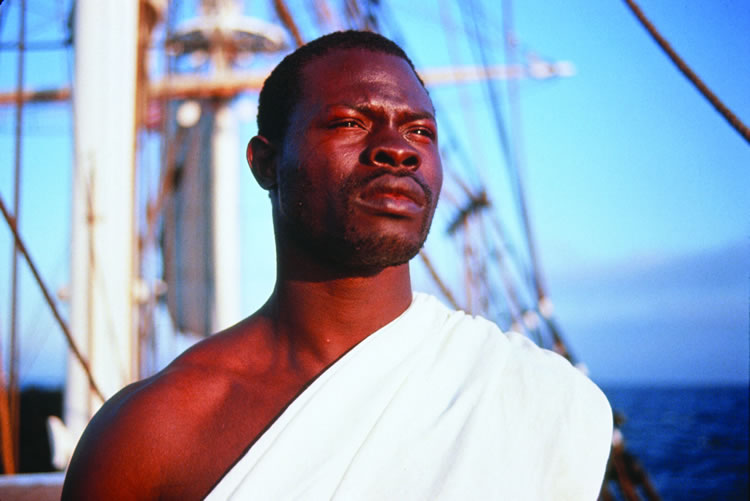
Locales such as Hato Rey and Rio Grande represented Bolivia, Colombia and Miami in “The Losers” (2010), starring Chris Evans. Then, in 2013, José Aponte de la Torre Airport in Ceiba and the San Juan Bay Marina easily substituted for the Costa Rican setting of “Runner Runner,” starring Ben Affleck and Justin Timberlake.
Puerto Rico’s locations also have been utilized to represent countries a little further afield. In Steven Spielberg’s Oscar-nominated drama “Amistad” (1997), scenes were shot at Castillo San Felipe del Morro, which was reimagined as an African slave depot. Later, the city of Bayamón and the sub-barrio of Puerta de Tierra in Old San Juan stood in for the Middle East and Vietnam in “The Men Who Stare at Goats” (2009).
Early to the Scene
Movie production in Puerto Rico really took off in the mid-1990s and has continued to gain steam into the 21st century as more and more of Hollywood’s movers and shakers discover this “hidden treasure” in the Caribbean. The history of filmmaking on the island, however, can be traced back to a century ago.
Puerto Rican cinema began as far back as the 1910s with the founding of the Film Industrial Society of Puerto Rico and the Tropical Film Co., which was dedicated to creating thought-provoking films—through documentaries and dramas—that explored the ever-evolving Puerto Rican culture.

Even though there were financial and technological limitations, innovative pioneers slowly brought Puerto Rico into the limelight. One such visionary was director Rafael Colorado D’Assoy with “Un Drama en Puerto Rico” (“A Drama in Puerto Rico”) in 1912, the island’s first fictional movie. Then, in 1934, Juan Emilio Viguié Cajas produced “Romance Tropical,” the first Puerto Rican film with sound.
For almost 50 years since that pivotal moment, the island’s film industry slowly evolved and gained wider acclaim internationally, reaching a pinnacle in 1967 when Leopoldo Torre Nilsson, director of “La Chica del Lunes” (“Monday’s Child”), was nominated for a Palme d’Or (Golden Palm)—the highest prize awarded at the Cannes Film Festival. Subsequently, “Lo que le Pasó a Santiago” (“What Happened to Santiago”) was nominated in 1989 for an Academy Award in the Best Foreign Language Film category.
Hollywood’s cinematic collaboration with Puerto Rico began slowly and sporadically with the 1951 thriller “The Man with My Face.” It took 12 years for the next film set on the island to arrive; in 1963, the adaptation of William Golding’s classic “Lord of the Flies” used Puerto Rico as a backdrop, followed by the Bob Hope comedy “The Private Navy of Sgt. O’Farrell” (1968) and Woody Allen’s 1971 comedic classic “Bananas.”
Homage to Puerto Rico
As Hollywood film production in Puerto Rico has developed over the years, several movies have incorporated the island into their plots. For example, the Kurt Russell comedy “Captain Ron” (1992) includes many scenes in the city of Fajardo and the immense El Yunque National Forest.
But according to Vivian Rebella, who has evolved from a location scout to a location manager, there is one Hollywood film that encapsulates the dynamic spirit and exotic character of Puerto Rico. “That would definitely be ‘The Rum Diary’; it captures the most of what Puerto Rico is all about,” she says of the 2011 film, which she worked on as an assistant location manager. “It was a great [shoot]. Johnny Depp was very professional.”

Since the Hunter S. Thompson novel and its film adaptation take place around the late 1950s and early 1960s, production designer Chris Seagers redesigned key areas around historic Old San Juan to capture the novel’s cultural narrative soul. One notable example was Sanderson’s (Aaron Eckhart) deluxe house built on a beach outside of Fajardo. And for the comedic scene where Paul Kemp (Depp) drove a car down a flight of stone steps into a building, the production and location crew incorporated a wide stairway in Old San Juan.
Rebella, who researches locales for Hollywood films like “The Rum Diary,” says her work provides a great sense of creative satisfaction and pride for her Puerto Rican home.
“What I love the most is that I [show] more aspects of my island,” says Rebella, who also has scouted locations for the Navy SEAL film “Act of Valor” (2012). “…We have all sorts of places and I especially love the creative part of presenting alternatives to make [the film shoot] happen. We’re very passionate about what we do. We have really good experiences from the cast and we’re very proud of our work. It becomes our lifestyle.”
This strong sense of professional pride can be found among Rebella’s many colleagues in the Puerto Rican film industry. It’s an old-fashioned work ethic that separates the true, groundbreaking pioneers from those who settle for mediocrity. Fernandez continues to be impressed by the island’s many film and television productions, as well as the talented workers.
“We probably have the most experienced bilingual crews … with over 60 production credits, and one of the most equipped rental houses in all of the Caribbean region,” he says. “We have been actively producing films and commercials since the 1970s. We have earned our position as [a] top filming destination.”
The Small Screen
Puerto Rico’s skilled film crews combined with the island’s chameleon-like nature to simulate other countries have been a boon for television productions as well, especially for the USA Network.
Fajardo and the island’s beaches substituted for Guam in “Covert Affairs.” When “Royal Pains” protagonist Dr. Hank Lawson (Mark Feuerstein) medically treats a close friend of Boris Keuster von Jurgens-Ratenicz (Campbell Scott) in Cuba, it’s Puerto Rico that provides the backdrop. Meanwhile, in the fourth season opener of “White Collar,” Plaza Colón and Hacienda Siesta Alegre served as a new home for Neal Caffrey (Matt Bomer) as he fled to Cape Verde Island.
Beyond the USA Network, in the third season of the Emmy Award-winning series “Homeland,” Puerto Rican landmarks encapsulate the Central American flavor of Venezuela. In the HBO sports comedy “Eastbound & Down,” a baseball stadium and cemetery in Old San Juan feature prominently in the second season when Kenny Powers (Danny McBride) temporarily leaves South Carolina to play baseball in Mexico.
More filming projects are being planned in Puerto Rico as 2014 continues. The “Pirates of the Caribbean” franchise is returning to the island for its fifth installment—the famed pirate ship, the Black Pearl, is already on location for repairs and preparations. Other productions that are scheduled to film later in the year include Universal Pictures’ “Midnight Delivery”; NBCUniversal’s pirate-inspired “Crossbones” TV show, which premieres this summer starring John Malkovich; and HBO’s “Boardwalk Empire.” The list goes on and on, Fernandez says, with filming endeavors recently venturing into commercials and the music industry.
While Puerto Rico’s distinct locations possess a special island charm that enhances a movie, television show or commercial, it also will enchant any discerning traveler who simply loves the beauty of nature and the history of an exotic culture.
***
Film Festivities
Puerto Rico is not only known for its film and television productions—it’s also home to a strong community of film lovers who host festivals throughout the year. From July 20-27, the Cinefiesta international short film festival will feature more than 2,000 short films from around the world. Every April, the Rincón International Film Festival showcases all genres of film in both English and Spanish language categories. Best of all, the festival takes place in the city of Rincón, one of the most renowned surfing hot spots in the Caribbean.
Other cinematic celebrations include the San Juan International Film Festival (Oct. 22-29); the Puerto Rico Horror Film Fest in October; the Puerto Rico International Film Fest and Convention (April 1); and the Festival of European Film (April 3-9). With so many engaging festivals, Puerto Rico continues to thrive as a premier film community for locals and visitors alike.

